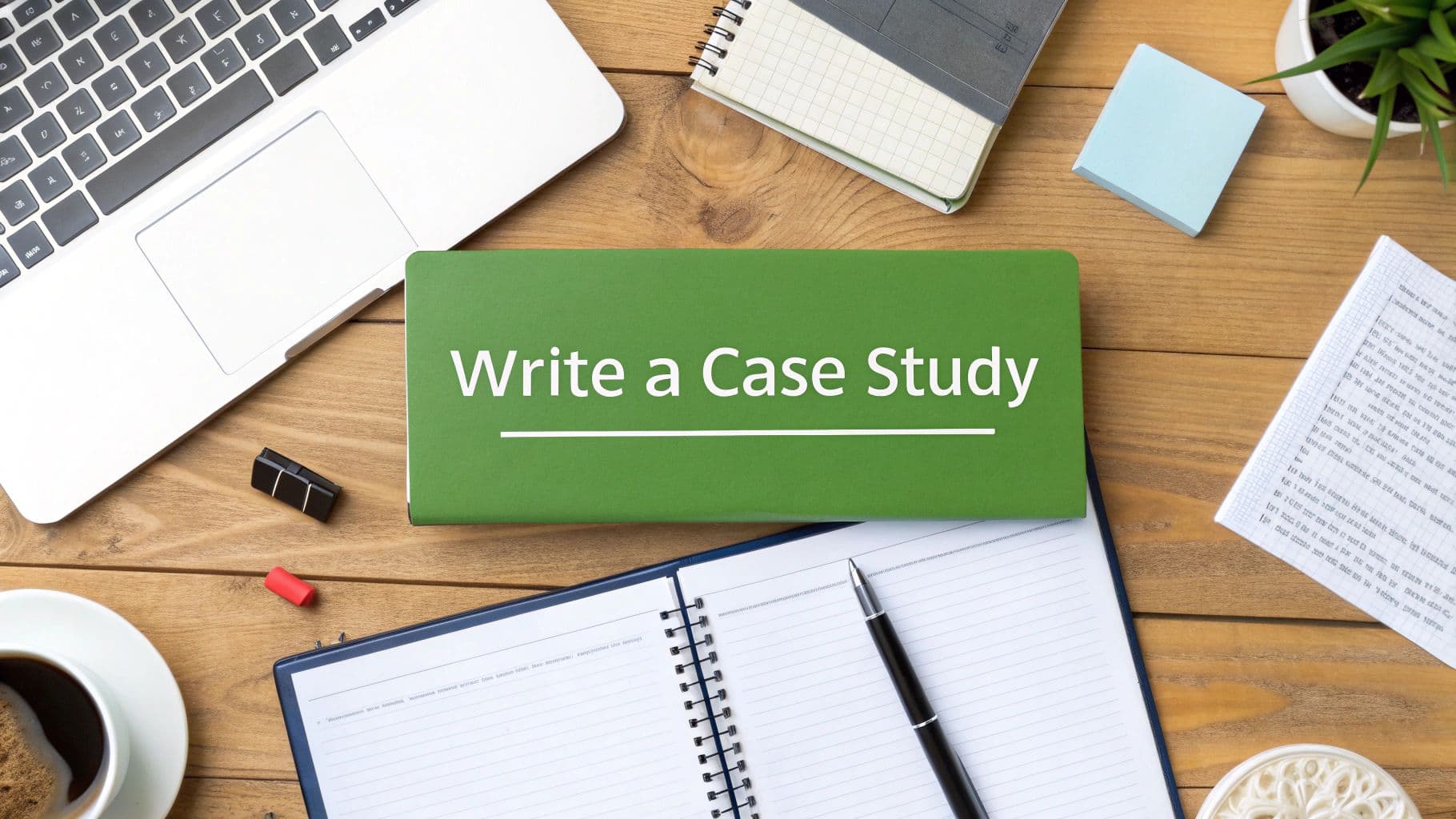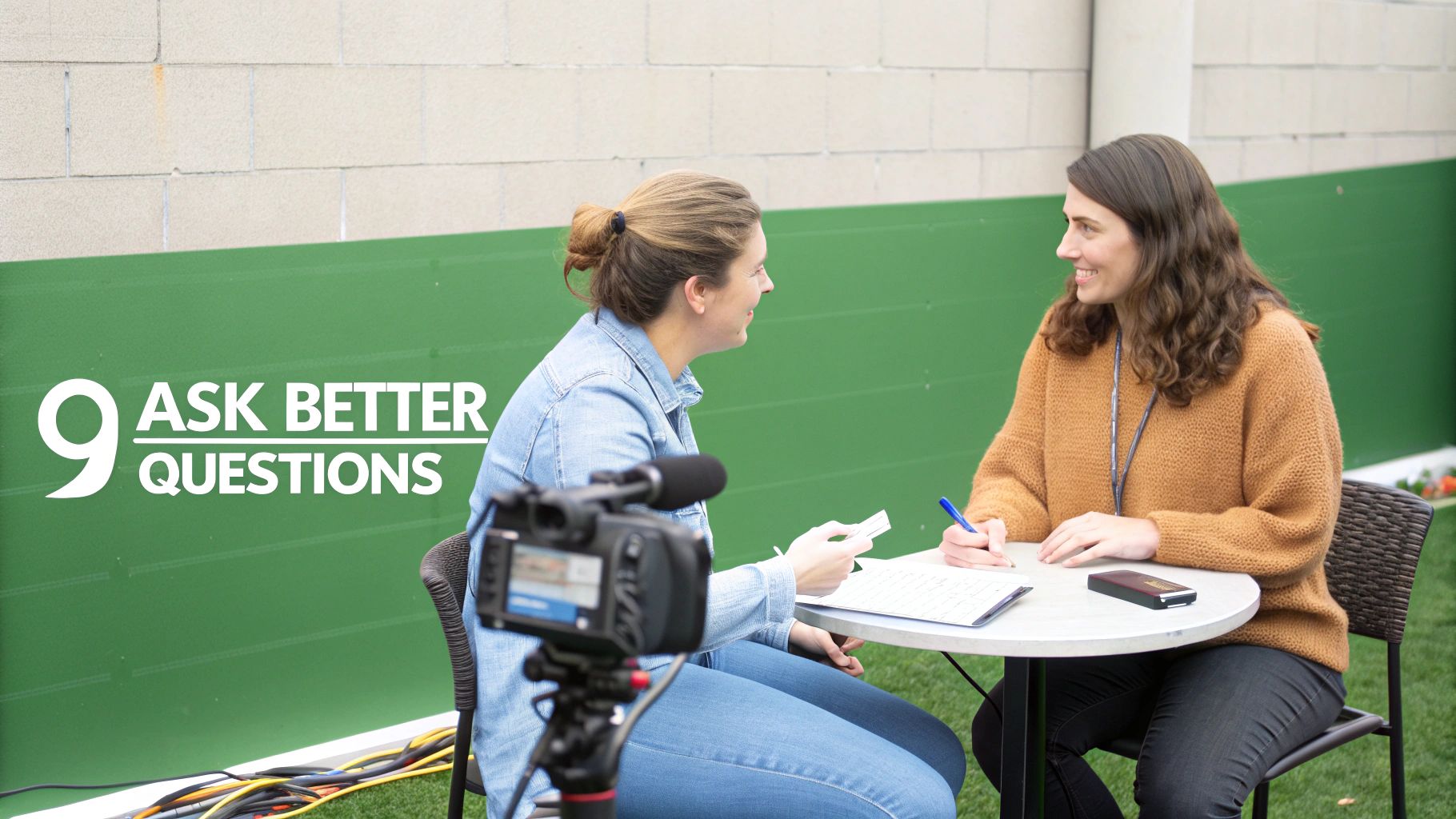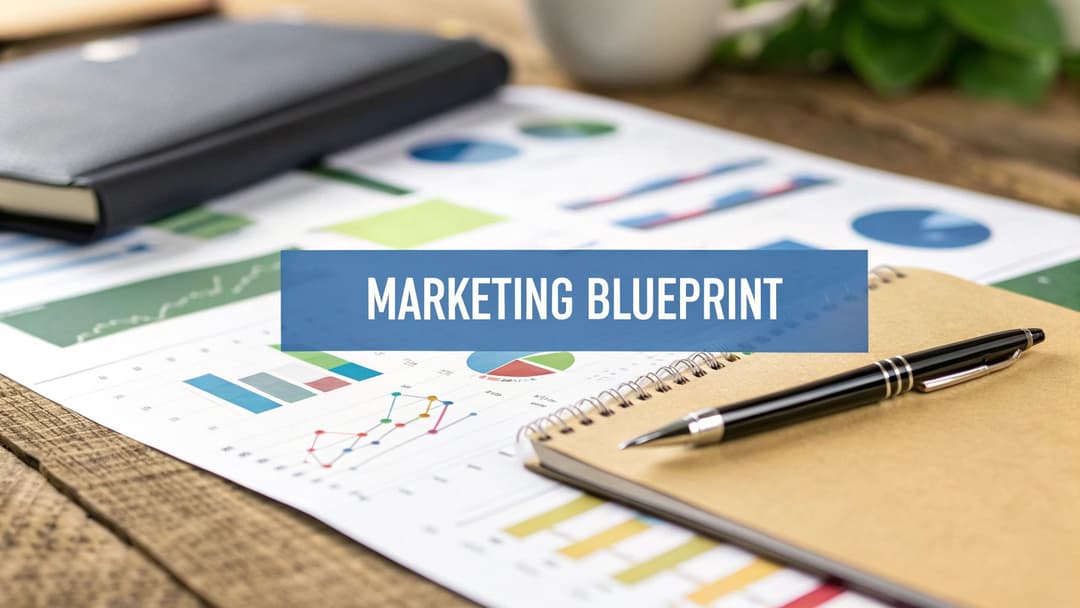
How to Write a Case Study: A Practical Guide
October 28, 2025
A case study is just a story about how you helped a customer win. That’s it. You find someone who’s had great success with your product or service, you interview them to get the real story (and the data to back it up), and then you shape that into a classic Problem-Solution-Results narrative. It's powerful, real-world proof that you deliver on your promises.
Why Case Studies Are Your Secret Sales Weapon

Forget those dry, technical reports nobody reads. Modern case studies are designed to build trust by showing—not just telling—how you solve real problems for businesses just like your prospect's. They’re the ultimate form of social proof.
A quick testimonial is nice, but a case study gives a hesitant buyer the detailed evidence they need to feel confident. It's the difference between a friend saying "the movie was good" and them walking you through the entire plot, explaining why the characters worked, and why it hit them so hard. One is an opinion; the other is a conviction.
Bridging the Trust Gap
In B2B sales, where decisions involve big budgets and multiple stakeholders, trust is everything. A well-told customer story closes that gap. It shows prospects you get their world and have a track record of delivering.
This isn’t just a theory; the data backs it up. According to HubSpot’s 2021 State of Marketing report, over 30% of marketers now see case studies as a primary tool. That’s a huge jump from just 13% the year before.
This shift shows just how much brands now rely on authentic stories to educate and convert. For a SaaS company, a single case study can be the tipping point in a major deal by demonstrating clear ROI and reassuring nervous decision-makers.
More Than Just a PDF
The best case studies don't just sit on a "Resources" page gathering digital dust. They've become versatile assets that can fuel your entire marketing engine.
- Sales Enablement: Your sales team can send targeted case studies to prospects wrestling with the exact same challenges.
- Content Marketing: You can pull key quotes and data points and turn them into social media posts, blog articles, and email newsletter snippets.
- Lead Generation: A particularly juicy case study can be gated on a landing page to capture high-intent leads.
A great case study doesn’t just report on success; it makes the reader feel that same success is attainable for them. It transforms abstract benefits into a concrete, believable outcome.
To really get a feel for how powerful these can be, it helps to see them in action. Before we jump into the "how-to," I'd suggest you browse a collection of successful case studies to see how different brands are telling their stories. It’ll give you a much better sense of what’s possible.
Finding the Right Customer and Setting the Stage

A great case study starts long before you write a single word. It starts with finding the right customer—the one whose story will connect with the exact prospects you want to attract. This isn't about finding just any happy client; it's about being strategic.
Think of your case study as a mirror. You want your ideal prospects to look at it and see themselves. They should recognize their own challenges, their industry, and their goals in the story you tell. That's why picking the right person is probably the most important decision you'll make in this whole process.
Identifying the Perfect Candidate
So, who makes a great candidate? It’s tempting to go with the first person who gives you a nice quote, but the best stories are built on tangible results. A customer saying they "love the new feature" is nice, but a customer who can prove they "increased lead generation by 40%" gives you a story with teeth. Hard data is what turns a reader from a skeptic into a believer.
Beyond the numbers, you need a story that fits your audience. If you're trying to break into the healthcare sector, a glowing testimonial from a retail brand just won't have the same impact. The industry, company size, and problem all need to align with who you're trying to sell to.
Here’s a quick gut check for spotting a winner:
- They have impressive results. Look for concrete data that shows a real, meaningful improvement.
- They have some brand recognition. Even if they're a well-respected name in a niche industry, that credibility rubs off on you.
- They’re articulate and enthusiastic. A passionate advocate is gold. You want someone who is genuinely excited to share their success.
- They have an unexpected use case. Sometimes, the most interesting stories come from customers who used your product in a creative way you never intended.
Defining Your Objective Before You Ask
Before you even think about sending that outreach email, you need to know what you want this case study to do. What’s the goal? Are you trying to prove ROI, highlight a little-used feature, or crack into a new market?
Without a clear objective, your questions will be vague and the final story will feel unfocused.
The purpose of a case study isn't just to document a past success; it's to create a blueprint for a future customer's success. Your objective should directly align with the action you want your target reader to take.
For example, your goal might be to:
- Prove ROI: Find a customer who can talk about the financial return they saw.
- Showcase a Specific Feature: Choose someone whose story perfectly illustrates the value of one key function.
- Target a New Industry: Pick a customer who is a leader in a market you’re trying to penetrate.
Getting this part right is the first step in understanding who you're writing for. To get deeper into this, you can check out our guide on what is audience analysis.
This quick table breaks down the essential parts of a compelling story.
Key Elements of a Compelling Case Study
| Component | Purpose | Key Question to Answer |
|---|---|---|
| The Protagonist | Makes the story relatable. | Who is the customer and what do they do? |
| The Problem | Creates tension and hooks the reader. | What specific challenge were they facing? |
| The Solution | Positions your product as the answer. | How did your product help them solve it? |
| The Results | Provides undeniable proof of value. | What measurable outcomes did they achieve? |
Thinking through these components beforehand will make your interview and writing process much smoother.
Making the Ask a True Partnership
Once you’ve got your target and a clear goal, it’s time to reach out. Don’t frame this as a favor you’re asking for. Instead, present it as a partnership that benefits both of you. Highlight the free exposure they’ll get on your blog, social media, and other channels. It’s a chance for them to be positioned as an innovator in their field.
Most importantly, make it ridiculously easy for them. Let them know exactly what to expect. Be clear about the time commitment—"a single 30-minute interview" is a lot less intimidating than a vague request. Reassure them that your team will do all the heavy lifting, from writing to design. A smooth, respectful process is how you get an enthusiastic "yes" and a story worth telling.
How to Interview for a Compelling Narrative

The interview is where a good case study becomes a great one. This is your chance to get past the generic praise and find the real story—the hard data and memorable quotes that will actually connect with your prospects.
Think of it less as a formal Q&A and more as a guided conversation.
Your main job is to make your customer comfortable enough to share what really happened. A relaxed person gives you the golden nuggets that bring a story to life: the specific frustrations they felt, the “aha!” moment they had, and the tangible impact of the results. This conversation is the absolute core of writing a case study that feels human.
Setting the Right Tone
You have to build rapport first. Before jumping into questions, spend a few minutes just chatting about their role, their company, or even a recent industry event. It’s a small step, but it completely changes the dynamic from an interrogation to a collaborative storytelling session.
And always, always get their permission to record the call. It frees you up to actually listen instead of scrambling to write everything down.
When you send that first invitation, a clear and professional message sets the right expectation from the get-go. If you need a little inspiration for getting the wording just right, check out a solid professional email example. Clarity from the start makes everything that follows so much smoother.
The best questions are open-ended. Steer clear of simple yes/no queries. Instead, use prompts that encourage a story, like, "Can you walk me through what things were like before?" or "Tell me about the moment you knew this was working."
Structuring Your Questions
I find it helps to organize questions around a classic story arc: the before, the during, and the after. This simple structure ensures you hit all the key parts of a powerful narrative.
The "Before" Questions (The Problem):
- What specific challenges made you start looking for a solution in the first place?
- Can you describe the pain points your team was dealing with day-to-day?
- What were the real business consequences of those challenges?
The "During" Questions (The Solution):
- What made you choose us over the other options you looked at?
- What was the implementation or onboarding process like for your team?
- Was there a specific feature that gave you that "aha!" moment?
The "After" Questions (The Results):
- What are the most significant improvements you've seen since we started?
- Can you share any specific numbers? (e.g., a percentage increase in efficiency, reduction in costs, time saved)
- What has the overall impact been on your team or the business as a whole?
Listening for the Story
During the interview, your most important job is to be an active listener. Don't just pay attention to what they say, but how they say it. Listen for those moments of passion, frustration, or excitement—that's where the best quotes hide.
Don't be afraid to ask simple follow-up questions. Things like, "That's interesting, can you tell me more about that?" or "What did that feel like?" can unlock the most valuable parts of the entire story.
Weaving a Story Your Prospects Will Actually Read

Alright, you've done the legwork and have a page full of interview notes. Now it's time to switch gears from researcher to storyteller. The goal here isn't to create a dry report; it's to spin that raw information into a compelling narrative that hooks your prospects from the first sentence.
Think of it this way: you're telling the story of a hero who was facing a huge challenge and, with your help, came out on top.
The most powerful case studies follow a classic formula for a simple reason: it works. It’s often called the Problem, Solution, Results framework. While the name is straightforward, the magic is in the execution. This structure guides your reader on a logical journey from a pain point they know all too well to an outcome they desperately want.
While 82% of SaaS companies stick to this traditional format, the ones that really stand out give it a modern storytelling twist. They're not just listing facts; they're building an actual narrative. If you're curious, you can learn more about SaaS case study trends and see how others are shaking things up.
Start With a Headline That Can't Be Ignored
Let's be honest: your headline is your one shot to grab someone's attention. A title like "Acme Inc. Case Study" is a one-way ticket to being ignored.
Instead, pull out the single most impressive, number-driven result you have and lead with it. A great headline is specific, promises value, and makes the reader think, "How did they do that?"
- Before: "Case Study: Company X and Our Software"
- After: "How Company X Slashed Project Timelines by 47% in Just Three Months"
See the difference? The second one immediately tells a busy reader what's in it for them and sets the stage for the story to unfold.
Introduce the Hero and Their Struggle
Every good story has a hero. In this story, the hero is your customer—not your company.
Start by introducing them. Who are they? What's their company? What’s their role? Just enough context so the reader can see themselves in their shoes.
Then, you hit them with the problem. This is where you build empathy. Don't just say what the challenge was; paint a picture of the frustration it caused. Pull those emotional soundbites and direct quotes from your interview to make the struggle feel real. A prospect reading this should nod along and think, "Yep, I know that feeling."
A case study fails when it talks about problems. It succeeds when it talks about people with problems. Frame the challenge in human terms—lost time, frustrated teams, missed opportunities—to create a powerful emotional hook.
Present Your Solution as the Turning Point
Once you've set the stakes, it's time to bring in your product or service as the tool that changed the game. But resist the urge to just list a bunch of features. That’s boring.
Instead, show how your solution directly tackled the specific pains you just described. This is where you connect the dots for the reader. Why did the customer choose you over everyone else? What was it like getting started? This is your chance to build credibility, but always, always keep the spotlight on the customer's journey.
Turning technical details into compelling arguments is an art. For a deeper look, our guide on persuasive writing techniques has some great, actionable tips.
Showcase the Win with Cold, Hard Data
Finally, you’ve reached the climax of the story: the results. This is where you deliver the payoff you promised in your headline.
Lead with your most powerful metrics. Make them impossible to miss.
- Use bullet points to make the key results pop off the page.
- Bold the numbers (e.g., "47% reduction in project timelines," "$1.2M in new revenue").
- Drop in a killer quote from the customer that drives home the impact.
This section delivers the logical proof that backs up the emotional connection you spent the whole time building. It’s that one-two punch of a relatable story and undeniable data that makes a case study so incredibly effective.
Designing and Promoting Your Case Study for Impact
Your work isn't done just because the writing is. A brilliant story needs a thoughtful design and a smart promotion plan to deliver real value. Let's be honest—a plain wall of text, no matter how well-written, will get ignored every single time.
This final stage is all about transforming your draft into a professional, scannable document that people actually want to read. The goal is to make your key points impossible to miss, even for someone just skimming.
Making Your Case Study Visually Engaging
Good design is more than just aesthetics; it's a tool for communication. It guides the reader’s eye directly to the most important information. Think about breaking up those long blocks of text with visual elements that make the story’s key takeaways pop.
Here are a few simple but powerful elements to work in:
- Pull Quotes: Find the most impactful customer quote you have and blow it up. Make it big, make it bold. This puts your customer's voice front and center.
- Data Visualizations: Don’t just say there was an increase. Show it. Turning key metrics into simple charts or graphs makes the results feel concrete. A visual showing a 47% increase is far more memorable than the number alone.
- Brand Logos: Including your customer’s logo adds instant credibility and makes the partnership feel official. It’s a small detail with a big impact.
- Strategic Bolding: Use bold text for the critical numbers, outcomes, and results. This ensures that even a skimmer can't miss the good stuff.
The ultimate goal of your case study's design is scannability. A busy executive should be able to grasp the core problem and the main result in under 30 seconds.
The Final Review and Customer Sign-Off
Before you hit publish, there's one last crucial checkpoint: the final review.
Send the complete, designed draft over to your customer for their approval. This isn't just a formality—it shows respect for your partnership and ensures they are completely comfortable with how their story is being told.
Make this process as painless as possible for them. A simple, friendly email with the PDF attached is all you need. Getting that official sign-off protects both of you and strengthens the relationship.
Turn One Asset Into a Marketing Engine
Once it's approved, it's time to unleash your story. But please, don't just stick it on a "Resources" page and hope for the best. A single, well-crafted case study can be repurposed into a powerful marketing engine.
Think bigger. Turn that one document into multiple assets:
- Social Media Graphics: Pull out the top statistic or a powerful quote and create a few shareable images for LinkedIn, Twitter, or wherever your audience lives.
- Sales Email Snippets: Arm your sales team with key results they can drop into their outreach emails. It’s instant credibility for their conversations.
- Landing Page Proof: Use the case study as social proof on pages related to the product or service you featured. A real-world result right next to a "buy" button is incredibly persuasive.
- Blog Post Inspiration: Write a new article that expands on one of the problems or solutions mentioned in the case study. Link back to the full document for those who want to dive deeper.
Answering Your Toughest Case Study Questions
Even with the best plan in the world, you’re going to hit a few snags. It happens to everyone. Let’s tackle some of the most common questions that pop up when you're deep in the case study trenches.
How Long Should This Thing Actually Be?
There's no magic word count, but most effective case studies land somewhere between 500 and 1,500 words. The real answer? It depends entirely on who you're writing for and how complex the story is.
Think about your audience. A busy C-level exec probably wants a one-page summary that cuts straight to the ROI. They don't have time for fluff. On the other hand, if you're writing for a technical manager, you'll need to dig into the nitty-gritty of the implementation to build credibility.
Here's my golden rule: make it long enough to tell the story well, but short enough to keep someone from drifting off.
What if My Customer Won't Share Hard Numbers?
First off, don't panic. This is an incredibly common hurdle. Most companies have strict policies about sharing specific revenue figures or exact percentage gains. It's not a deal-breaker; it just means you need to get a little creative.
When hard data is off the table, you have to pivot to qualitative results and directional metrics. These can be just as powerful when framed correctly.
Try using descriptive phrases that still paint a picture of success:
- "A significant jump in team efficiency."
- "Slashed the manual workload by more than half."
- "What used to take weeks now takes just a few days."
You can also use ranges or talk about the sheer scale of the improvement. Phrases like "drove a multi-million dollar impact" or "we saw a double-digit lift in conversions" convey massive value without breaking any confidentiality agreements. The goal is to show undeniable impact, even if the numbers stay behind the curtain.
How Do I Convince a Customer to Do This?
It all starts with picking the right person. Zero in on your happiest, most successful customers—the ones who are genuinely thrilled with the results they’ve gotten.
When you reach out, don't make it sound like you're asking for a favor. Frame it as a co-promotional opportunity. You’re not just writing about them; you’re showcasing their company’s success and highlighting how innovative they are. It's great brand exposure for them, and it costs them nothing.
The most important part? Make it ridiculously easy for them. Be crystal clear about the time commitment (e.g., "all we need is a single 30-minute call") and promise them you'll handle all the heavy lifting—the writing, the design, everything. A small thank-you, like a gift card or a product discount, never hurts either. It’s a nice touch that makes the whole thing feel more like a partnership.
Turning interview notes into a story that clicks with readers is tough work. If your drafts feel a bit lifeless or still have that "AI" feel, Natural Write can give them the polish they need. Our platform refines text to read with natural clarity, making sure your customer's success story truly connects and bypasses AI detection. Humanize your case study with one click at https://naturalwrite.com.


